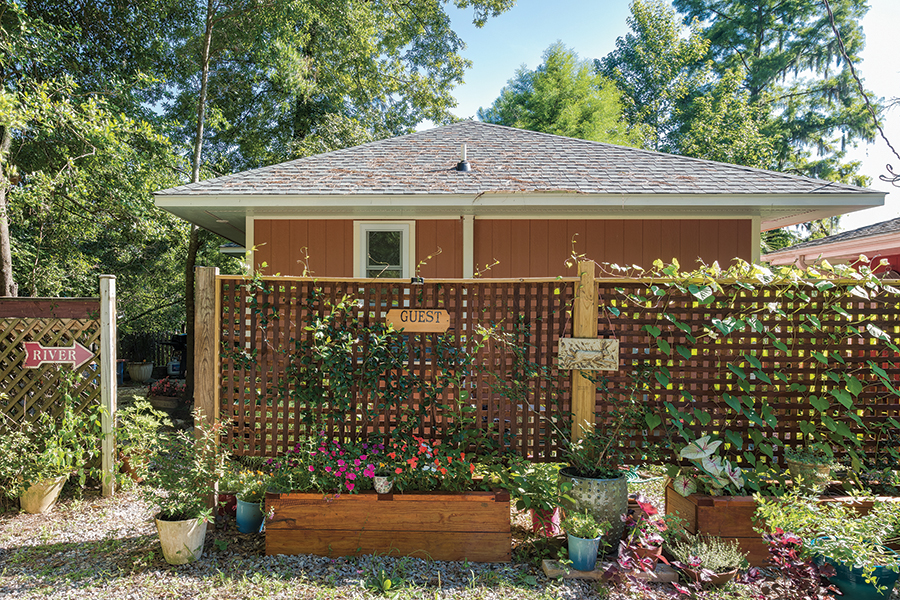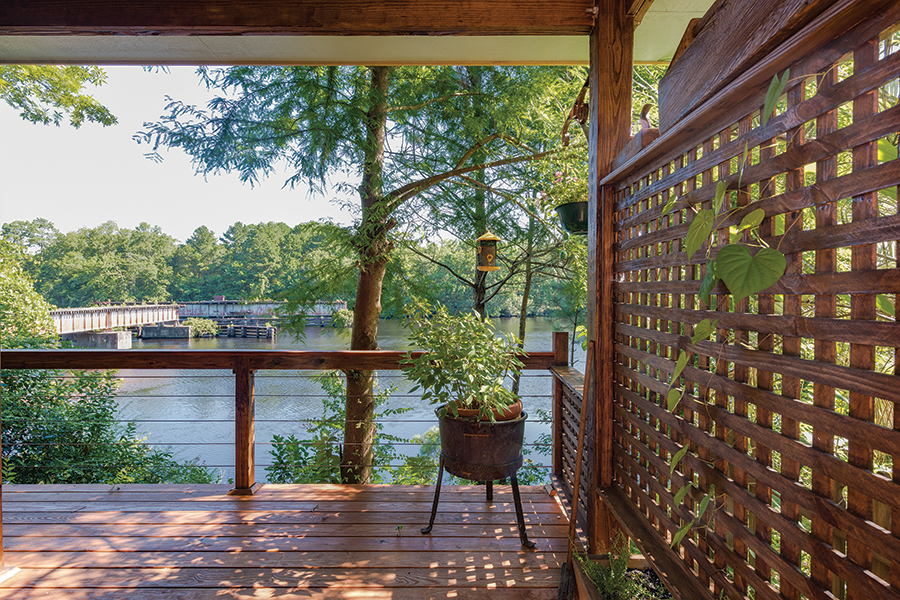A tiny retreat on the Cape Fear is the perfect place to recharge
By John Wolfe • Photographs by Rick Ricozzi
There are certain places on this planet, made distinctive by their rarity, where the passage of time moves slowly enough to be fully appreciated and enjoyed. Often in these places, a branch of the natural world resides near enough to usurp man-made timekeeping devices, returning the place to a tempo of unhurried, wild immediacy. At the Bridge Tender’s River Lodge in Castle Hayne, a guest retreat cabin built and decorated by Doug Springer and Diane Upton, it is the Northeast Cape Fear River that sets the pace as it flows by the front door, on its steady journey back to the Atlantic.

Doug and Diane are as tied to this river as any couple can claim to be. Together with four other partners, they own and operate Wilmington Water Tours, a river cruise company that reveals, to all who wish to know, the ecological and historical secrets of the river coursing past the streets of the Port City. Doug also served as the Cape Fear riverkeeper from 2007 until 2010, when he passed the mantle to current riverkeeper Kemp Burdette. Doug and Diane love the river not just for its natural beauty — “You should see it in October,” Diane tells me — but for its historical and sociological importance as well. Just upriver from the lodge, Doug says, was what is believed to be the first drawbridge in North America, the site of an 8,000-man prisoner exchange during the Civil War, and a strategically important spot the patriots occupied during the American Revolution. Of the thousands of lead bullets found on the river’s bottom from those time periods, most had a single hole drilled through them, meaning they were not fired in anger, but rather used as sinkers in the makeshift fishing rigs of bored soldiers. Doug also mentions an English pipe found nearby that dates back to 1570, a date which makes me look at the river a little differently. What other ancient secrets do these whispering waters hold?

The lodge is the perfect place to wonder such thoughts, for it is a dwelling built to point in one direction — toward the river. Every seat in the lodge offers river views, thanks to wide front windows and a strategically placed mirror on the back wall, but the best seats by far are out on the wide, amber-stained front porch. A ponderer has their pick between rocking chairs, or a well-loved cotton hammock. The view of the river (which is never the same twice) is framed on one side by a cypress tree which Doug and Diane found as a seedling on one of their excursions upriver; now relocated and grown, it reaches skyward and offers the blue-green dragonflies a branch on which to light. An often-visited bird feeder hangs from another branch, beneath silver cascades of Spanish moss. At the left-hand edge of the framed river, we are given a manmade object to ruminate on, one which, by its presence, creates a delightful contrast with the larger natural world surrounding it: the old railroad bridge, from which the lodge draws its name. Once part of the Wilmington-Weldon Railroad (the longest railroad in the world for a brief yet exciting moment in 1840), the bridge has slowly assimilated with the river it spans. Red rust bleeds through its silver paint. Green plants shoot up through its abandoned tracks. It is a fitting piece to ponder in a place where the sounds of the distant highway are drowned out by the droning thrum of cicadas.

The cozy interior of the lodge offers everything a person could need, with nothing extraneous to distract from the flowing waters and wildflowers just beyond the threshold. The main room is open and airy, separated from the well-appointed Lilliputian kitchen by a black marble bar, which doubles as the kitchen table. The kitchen counter (and the bathroom’s, as well) is one solid slab of varnished pine, lending a rustic log-cabin feel that nicely balances out the modern appliances. The windows are high on the walls, offering privacy while allowing in an abundance of natural light, and are framed with blond unfinished wood. Diane has curated the space with a homey, lived-in feeling; this comes from the liberal use of local artifacts like brown growler bottles from Waterline Brewery, an assortment of CDs from local musicians in a basket atop the stereo, a longleaf pine cone perched on a windowsill (“Here’s to the land of the longleaf pine,” as the Old North State’s celebrated toast begins), and a hat hook by the door made from a railroad spike pulled from the adjacent tracks. Leaning against the stereo is a 3/4-scale Taylor acoustic guitar (which, I am happy to report, does a marvelous job of serenading the river from the porch on warm summer nights).

The lodge was designed by Ron Wilson, who has won awards for green building while teaching architecture at Cape Fear Community College. The unique two-gabled roof design transforms the 20-by-20-foot structure from a box into a home. The building was brought from the page into reality by local builder and waterman Charles Robbins, a longtime friend of the couple’s. “He built it like it was his own house,” said Doug. “It’s well insulated, and very energy efficient.” The construction took only six months, thanks to Robbins’s 40 years of building experience.
Anybody who wishes to build his or her own river lodge need only contact Doug: He has offered to give the plans away, free of charge, to anyone who would like to build a river lodge (or a creek lodge, for that matter). Presumably this stems from his environmentalist background; if you live by the water, you start forming a personal connection, and realize not just your own relationship to our planet but your responsibility to it, as well. Becoming an environmentalist is easy, as David Gessner has written; just fall in love with a place and then fight for it. Caring for the planet often begins in one backyard, or on one body of water. Each place is connected to everywhere else.

Here at the lodge, one feels that connection strongly. This cozy cabin on the banks of the mighty Cape Fear is a place to recharge one’s batteries, a breath of stillness and peace amid life’s commotion and chaos.
John Wolfe studied creative nonfiction at UNCW. When he’s not in the water, he wishes he were.


